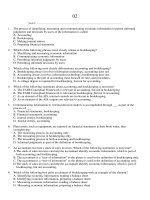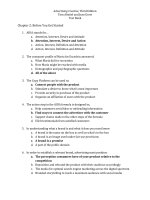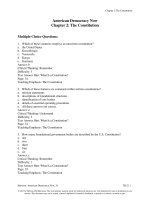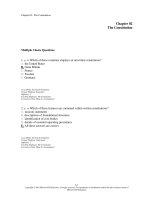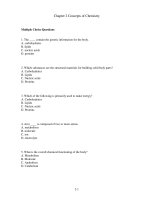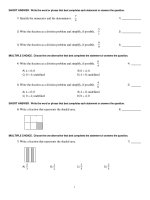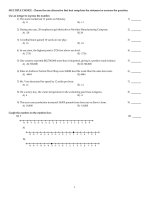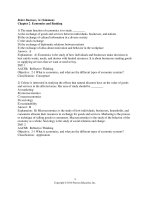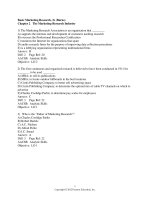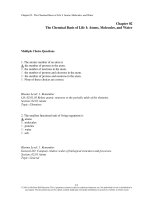American democracy now 3rd edition harrison test bank
Bạn đang xem bản rút gọn của tài liệu. Xem và tải ngay bản đầy đủ của tài liệu tại đây (180.38 KB, 19 trang )
Chapter 2 The Constitution
American Democracy Now
Chapter 2: The Constitution
Multiple-Choice Questions:
1. Which of these countries employs an unwritten constitution?
a. the United States
b. Great Britain
c. Venezuela
d. Kenya
e. Germany
Answer: b
Critical Thinking: Remember
Difficulty: 3
Text Answer Hint: What Is a Constitution?
Page: 34
Teaching Emphasis: The Constitution
2. Which of these features are contained within written constitutions?
a. mission statements
b. descriptions of foundational structures
c. identification of core bodies
d. details of essential operating procedures
e. All these answers are correct.
Answer: e
Critical Thinking: Understand
Difficulty: 2
Text Answer Hint: What Is a Constitution?
Page: 34
Teaching Emphasis: The Constitution
3. How many foundational government bodies are described by the U.S. Constitution?
a. one
b. two
c. three
d. four
e. six
Answer: c
Critical Thinking: Remember
Difficulty: 1
Text Answer Hint: What Is a Constitution?
Page: 35
Teaching Emphasis: The Constitution
Harrison: American Democracy Now, 3e
TB-2 | 1
© 2013 by McGraw-Hill Education. This is proprietary material solely for authorized instructor use. Not authorized for sale or distribution in any
manner. This document may not be copied, scanned, duplicated, forwarded, distributed, or posted on a website, in whole or part.
Chapter 2 The Constitution
4. According to the Constitution,
a. the legislature enforces the law.
b. the executive makes the law.
c. the Supreme Court interprets the law.
d. the bureaucrats make the law.
e. interest groups shape the law.
Answer: c
Critical Thinking: Understand
Difficulty: 2
Text Answer Hint: What Is a Constitution?
Page: 36
Teaching Emphasis: The Constitution
5. Which of these dates marked the War for Independence?
a. 1756–1763
b. 1765–1775
c. 1770–1780
d. 1775–1783
e. 1776–1785
Answer: d
Critical Thinking: Remember
Difficulty: 1
Text Answer Hint: The Creation of the United States of America
Page: 36
Teaching Emphasis: The Constitution
6. Which of the following statements best describes the eighteenth-century colonists’ desire for
government by the people?
a. popular sovereignty
b. representational democracy
c. universal suffrage
d. government established to protect the people’s liberties
e. a two-tiered system of government, with power split between Britain and the colonies
Answer: a
Critical Thinking: Understand
Difficulty: 2
Text Answer Hint: The Creation of the United States of America
Page: 36
Teaching Emphasis: The Constitution
Harrison: American Democracy Now, 3e
TB-2 | 2
© 2013 by McGraw-Hill Education. This is proprietary material solely for authorized instructor use. Not authorized for sale or distribution in any
manner. This document may not be copied, scanned, duplicated, forwarded, distributed, or posted on a website, in whole or part.
Chapter 2 The Constitution
7. Indentured servants were those who worked for a number of years
a. for a master in America, then returned to Europe.
b. for a master in America who had paid for their passage.
c. for a master in America after being transported against their will.
d. in America, then gained access to land and other property.
e. for a master in America, then left for the Caribbean and Mexico.
Answer: b
Critical Thinking: Understand
Difficulty: 23
Text Answer Hint: The Creation of the United States of America
Page: 36
Teaching Emphasis: The Constitution
8. In the two-tiered system of colonial government in the early eighteenth century, which group
had authority over day-to-day matters?
a. local officials and assemblies
b. Parliament
c. governors appointed by royal authority
d. the king
e. the British Cabinet
Answer: a
Critical Thinking: Remember
Difficulty: 2
Text Answer Hint: The Creation of the United States of America
Page: 36
Teaching Emphasis: The Constitution
9. In the two-tiered system of colonial government in the early eighteenth century, which group
had authority to enact laws that applied both to colonists and to people in Great Britain?
a. local officials and assemblies
b. Parliament
c. governors appointed by royal authority
d. the king
e. the British Cabinet
Answer: b
Critical Thinking: Remember
Difficulty: 3
Text Answer Hint: The Creation of the United States of America
Page: 36
Teaching Emphasis: The Constitution
Harrison: American Democracy Now, 3e
TB-2 | 3
© 2013 by McGraw-Hill Education. This is proprietary material solely for authorized instructor use. Not authorized for sale or distribution in any
manner. This document may not be copied, scanned, duplicated, forwarded, distributed, or posted on a website, in whole or part.
Chapter 2 The Constitution
10. The Seven Years’ War was fought between
a. Britain and Holland.
b. Britain and Russia.
c. Britain and France.
d. Britain and Spain.
e. Britain and Portugal.
Answer: c
Critical Thinking: Remember
Difficulty: 2
Text Answer Hint: The Creation of the United States of America
Page: 37
Teaching Emphasis: The Constitution
11. The Sugar Act (1764) imposed tax increases on which of these commodities?
a. sugar
b. molasses
c. coffee
d. textiles
e. All these answers are correct.
Answer: e
Critical Thinking: Remember
Difficulty: 1
Text Answer Hint: The Creation of the United States of America
Page: 37
Teaching Emphasis: The Constitution
12. Which of the following chronologies is correct?
a. Stamp Act, Sugar Act, Declaratory Act, Townshend Duties Act
b. Sugar Act, Stamp Act, Declaratory Act, Townshend Duties Act
c. Declaratory Act, Sugar Act, Stamp Act, Townshend Duties Act
d. Sugar Act, Declaratory Act, Stamp Act, Townshend Duties Act
e. Stamp Act, Declaratory Act, Sugar Act, Townshend Duties Act
Answer: b
Critical Thinking: Remember
Difficulty: 3
Text Answer Hint: The Creation of the United States of America
Page: 37
Teaching Emphasis: The Constitution
Harrison: American Democracy Now, 3e
TB-2 | 4
© 2013 by McGraw-Hill Education. This is proprietary material solely for authorized instructor use. Not authorized for sale or distribution in any
manner. This document may not be copied, scanned, duplicated, forwarded, distributed, or posted on a website, in whole or part.
Chapter 2 The Constitution
13. In 1768, the ________ colonial legislature petitioned King George III to repeal the
Townshend Act.
a. New Hampshire
b. Virginia
c. Maryland
d. Massachusetts
e. Rhode Island
Answer: d
Critical Thinking: Remember
Difficulty: 3
Text Answer Hint: The Creation of the United States of America
Page: 37
Teaching Emphasis: The Constitution
14. In 1770, how many British soldiers were quartered among the 16,000 civilians living in
Boston?
a. 400
b. 2,400
c. 4,000
d. 14,000
e. 20,000
Answer: c
Critical Thinking: Remember
Difficulty: 3
Text Answer Hint: The Creation of the United States of America
Page: 37
Teaching Emphasis: The Constitution
15. Who formed the Massachusetts Committee of Correspondence in 1772?
a. John Hancock
b. Paul Revere
c. Patrick Henry
d. Samuel Adams
e. Benjamin Franklin
Answer: d
Critical Thinking: Remember
Difficulty: 2
Text Answer Hint: The Creation of the United States of America
Page: 38
Teaching Emphasis: The Constitution
Harrison: American Democracy Now, 3e
TB-2 | 5
© 2013 by McGraw-Hill Education. This is proprietary material solely for authorized instructor use. Not authorized for sale or distribution in any
manner. This document may not be copied, scanned, duplicated, forwarded, distributed, or posted on a website, in whole or part.
Chapter 2 The Constitution
16. Which group gained a monopoly over the tea trade after the passage of the Tea Act (1773)?
a. a shipping cartel led by John Hancock
b. the East India Tea Company
c. business interests connected to King George III
d. French and Dutch traders
e. Mohawk Indians
Answer: b
Critical Thinking: Remember
Difficulty: 1
Text Answer Hint: The Creation of the United States of America
Page: 38
Teaching Emphasis: The Constitution
17. What repercussions followed the Boston Tea Party of December 16, 1773?
a. passage of the Coercive Acts
b. closure of the port of Boston
c. imposition of martial law
d. prohibition of the colonial assembly and town meetings
e. All these answers are correct.
Answer: e
Critical Thinking: Understand
Difficulty: 2
Text Answer Hint: The Creation of the United States of America
Page: 38
Teaching Emphasis: The Constitution
18. In September 1774, all colonies sent delegates to the First Continental Congress EXCEPT
a. Delaware.
b. Georgia.
c. Rhode Island.
d. New York.
e. New Hampshire.
Answer: b
Critical Thinking: Remember
Difficulty: 2
Text Answer Hint: The Creation of the United States of America
Page: 38
Teaching Emphasis: The Constitution
Harrison: American Democracy Now, 3e
TB-2 | 6
© 2013 by McGraw-Hill Education. This is proprietary material solely for authorized instructor use. Not authorized for sale or distribution in any
manner. This document may not be copied, scanned, duplicated, forwarded, distributed, or posted on a website, in whole or part.
Chapter 2 The Constitution
19. The assembled delegates at the Second Continental Congress
a. called for a truce in the hostilities with the British.
b. demanded participation in Parliament’s policy-making processes.
c. empowered Congress to function as an independent government.
d. appointed Samuel Adams to command the Continental Army.
e. adopted the Declaration of Rights and Grievances.
Answer: c
Critical Thinking: Understand
Difficulty: 2
Text Answer Hint: The Creation of the United States of America
Page: 38
Teaching Emphasis: The Constitution
20. According to Thomas Paine’s Common Sense, ________ was the only option that would
ensure American liberty and religious freedom.
a. diplomacy
b. civil disobedience
c. parliamentary representation
d. popular protest
e. war
Answer: e
Critical Thinking: Understand
Difficulty: 2
Text Answer Hint: The Creation of the United States of America
Page: 39
Teaching Emphasis: The Constitution
21. At the Second Continental Congress, who argued that “these united Colonies are, and of right
ought to be free and independent States”?
a. Richard Henry Lee
b. Thomas Jefferson
c. James Madison
d. Samuel Adams
e. John Hancock
Answer: a
Critical Thinking: Remember
Difficulty: 3
Text Answer Hint: The Creation of the United States of America
Page: 39
Teaching Emphasis: The Constitution
Harrison: American Democracy Now, 3e
TB-2 | 7
© 2013 by McGraw-Hill Education. This is proprietary material solely for authorized instructor use. Not authorized for sale or distribution in any
manner. This document may not be copied, scanned, duplicated, forwarded, distributed, or posted on a website, in whole or part.
Chapter 2 The Constitution
22. Which of the following thinkers influenced the creation of the Declaration of Independence?
a. Thomas Paine
b. Thomas Hobbes
c. Jean-Jacques Rousseau
d. John Locke and Thomas Paine
e. Jean-Jacques Rousseau and John Locke
Answer: e
Critical Thinking: Remember
Difficulty: 3
Text Answer Hint: The Creation of the United States of America
Page: 39
Teaching Emphasis: The Constitution
23. Which of the following is a central principle of the Declaration of Independence?
a. all men are equal
b. natural rights are derived from the consent of the governed
c. freedom is derived from the right to vote
d. all men must relinquish their inalienable rights to the authority of the sovereign
e. all men deserve the right to vote and gain parliamentary representation based on population
numbers
Answer: a
Critical Thinking: Analyze
Difficulty: 2
Text Answer Hint: The Creation of the United States of America
Page: 39
Teaching Emphasis: The Constitution
24. Which of these states enacted state constitutions in 1777?
a. New York, Georgia, and Vermont
b. Georgia, Massachusetts, and Vermont
c. New York, Connecticut, and Rhode Island
d. Connecticut, Georgia, and Rhode Island
e. Vermont, Georgia, and Massachusetts
Answer: a
Critical Thinking: Remember
Difficulty: 2
Text Answer Hint: The Creation of the United States of America
Page: 40
Teaching Emphasis: The Constitution
Harrison: American Democracy Now, 3e
TB-2 | 8
© 2013 by McGraw-Hill Education. This is proprietary material solely for authorized instructor use. Not authorized for sale or distribution in any
manner. This document may not be copied, scanned, duplicated, forwarded, distributed, or posted on a website, in whole or part.
Chapter 2 The Constitution
25. Why were the new state constitutions revolutionary?
a. They were unwritten but strictly followed, unlike the English constitution.
b. They were the accumulation of laws written over time and based on customs and traditions.
c. They were adopted at a specific moment in time.
d. They established independence, yet still submitted to the rule of a king.
e. They lacked the specified principles and structures of previous constitutions.
Answer: c
Critical Thinking: Analyze
Difficulty: 3
Text Answer Hint: The Creation of the United States of America
Page: 40
Teaching Emphasis: The Constitution
26. Which state, the only one to do so, saw citizen voters ratify their state constitution?
a. Georgia
b. Vermont
c. Rhode Island
d. Connecticut
e. Massachusetts
Answer: e
Critical Thinking: Remember
Difficulty: 3
Text Answer Hint: The Creation of the United States of America
Page: 40
Teaching Emphasis: The Constitution
27. Bicameral legislatures contain two separate parts, known as
a. departments.
b. chambers.
c. houses.
d. parliaments.
e. bodies.
Answer: b
Critical Thinking: Remember
Difficulty: 2
Text Answer Hint: The Creation of the United States of America
Page: 40
Teaching Emphasis: The Constitution
Harrison: American Democracy Now, 3e
TB-2 | 9
© 2013 by McGraw-Hill Education. This is proprietary material solely for authorized instructor use. Not authorized for sale or distribution in any
manner. This document may not be copied, scanned, duplicated, forwarded, distributed, or posted on a website, in whole or part.
Chapter 2 The Constitution
28. How many governing bodies were created for the United States within the Articles of
Confederation?
a. one
b. two
c. three
d. four
e. six
Answer: a
Critical Thinking: Remember
Difficulty: 2
Text Answer Hint: The Creation of the United States of America
Page: 41
Teaching Emphasis: The Constitution
29. Which of the following statements reflect the constitutional structure within the Articles of
Confederation (1781–1789)?
a. Approval of policies and treaty ratification required nine affirmative votes.
b. State courts retained jurisdiction over most legal matters, except in cases of inter-state
conflict.
c. State governments would implement and pay for congressionally-approved policies.
d. Any constitutional amendments required unanimous approval of all 13 states.
e. All these answers are correct.
Answer: e
Critical Thinking: Understand
Difficulty: 2
Text Answer Hint: The Creation of the United States of America
Page: 41
Teaching Emphasis: The Constitution
30. Which of the following chronological sequences of events is correct?
a. Boston Tea Party; First Continental Congress; Declaration of Independence
b. Shays’s Rebellion; Annapolis Convention; Declaration of Independence
c. Declaration of Independence; Stamp Act; Philadelphia Convention
d. Articles of Confederation; Declaration of Independence; Annapolis Convention
e. First Continental Congress; Stamp Act; Articles of Confederation
Answer: a
Critical Thinking: Remember
Difficulty: 3
Text Answer Hint: The Creation of the United States of America
Page: 38-42
Teaching Emphasis: The Constitution
Harrison: American Democracy Now, 3e
TB-2 | 10
© 2013 by McGraw-Hill Education. This is proprietary material solely for authorized instructor use. Not authorized for sale or distribution in any
manner. This document may not be copied, scanned, duplicated, forwarded, distributed, or posted on a website, in whole or part.
Chapter 2 The Constitution
31. Shays’s Rebellion
a. was a successful revolt.
b. convinced many political leaders that the national government was too powerful.
c. convinced many political leaders that the national government was not powerful enough.
d. reinforced public support for the Articles of Confederation.
e. occurred after the Philadelphia Convention of 1787.
Answer: c
Critical Thinking: Understand
Difficulty: 2
Text Answer Hint: The Creation of the United States of America
Page: 42
Teaching Emphasis: The Constitution
32. Which state was the only one of the following that did NOT send delegates to the
Constitutional Convention on 1787?
a. New England
b. Rhode Island
c. New York
d. New Jersey
e. Maryland
Answer: b
Critical Thinking: Remember
Difficulty: 3
Text Answer Hint: Crafting the Constitution: Compromise, Ratification, and Quick Amendment
Page: 42
Teaching Emphasis: The Constitution
33. Whose work, entitled The Spirit of the Laws (1748), provided the concept of separation of
powers later adopted by the framers of the Constitution?
a. John Locke
b. Thomas Hobbes
c. Jean-Jacques Rousseau
d. Baron de Montesquieu
e. François-Marie Arouet
Answer: d
Critical Thinking: Remember
Difficulty: 2
Text Answer Hint: Crafting the Constitution: Compromise, Ratification, and Quick Amendment
Page: 43
Teaching Emphasis: The Constitution
Harrison: American Democracy Now, 3e
TB-2 | 11
© 2013 by McGraw-Hill Education. This is proprietary material solely for authorized instructor use. Not authorized for sale or distribution in any
manner. This document may not be copied, scanned, duplicated, forwarded, distributed, or posted on a website, in whole or part.
Chapter 2 The Constitution
34. At Philadelphia, who proposed the Virginia Plan, which included a three-branch
government?
a. James Madison
b. William Paterson
c. Benjamin Franklin
d. George Washington
e. John Hancock
Answer: a
Critical Thinking: Remember
Difficulty: 2
Text Answer Hint: Crafting the Constitution: Compromise, Ratification, and Quick Amendment
Page: 43
Teaching Emphasis: The Constitution
35. The Connecticut Compromise (or Great Compromise) produced
a. checks and balances.
b. the abolition of slavery.
c. a bicameral Congress.
d. separation of powers.
e. federalism.
Answer: c
Critical Thinking: Understand
Difficulty: 2
Text Answer Hint: Crafting the Constitution: Compromise, Ratification, and Quick Amendment
Page: 45
Teaching Emphasis: The Constitution
36. What issue led to the Three-Fifths Compromise?
a. states rights
b. individual liberty versus federal power
c. slavery
d. foreign treaties
e. disagreement over separation of powers
Answer: c
Critical Thinking: Remember
Difficulty: 1
Text Answer Hint: Crafting the Constitution: Compromise, Ratification, and Quick Amendment
Page: 46
Teaching Emphasis: The Constitution
Harrison: American Democracy Now, 3e
TB-2 | 12
© 2013 by McGraw-Hill Education. This is proprietary material solely for authorized instructor use. Not authorized for sale or distribution in any
manner. This document may not be copied, scanned, duplicated, forwarded, distributed, or posted on a website, in whole or part.
Chapter 2 The Constitution
37. The writers of the Constitution devised the Electoral College as the method of choosing
presidents because
a. direct election was impractical, due to the poor systems of communication and transportation
that existed in the late 1700s.
b. the method would shield executive power from popular majorities and Congress.
c. the method guaranteed a majority winner.
d. the method would give weight to the preferences of ordinary people.
e. the framers had a great deal of faith in the wisdom of the masses.
Answer: b
Critical Thinking: Analyze
Difficulty: 2
Text Answer Hint: Crafting the Constitution: Compromise, Ratification, and Quick Amendment
Page: 45
Teaching Emphasis: The Constitution
38. Under the original Constitution, Congress could not ban the slave trade until ________.
a. 1808
b. 1818
c. 1828
d. 1857
e. 1865
Answer: a
Critical Thinking: Remember
Difficulty: 1
Text Answer Hint: Crafting the Constitution: Compromise, Ratification, and Quick Amendment
Page: 46
Teaching Emphasis: The Constitution
39. According to Article I of the Constitution, a proposed piece of legislation requires a
________ in both the House and Senate to become law.
a. simple majority of votes
b. three-fifths majority vote
c. two-thirds majority vote
d. three-quarters majority vote
e. unanimous vote
Answer: a
Critical Thinking: Remember
Difficulty: 1
Text Answer Hint: Crafting the Constitution: Compromise, Ratification, and Quick Amendment
Page: 47
Teaching Emphasis: The Constitution
Harrison: American Democracy Now, 3e
TB-2 | 13
© 2013 by McGraw-Hill Education. This is proprietary material solely for authorized instructor use. Not authorized for sale or distribution in any
manner. This document may not be copied, scanned, duplicated, forwarded, distributed, or posted on a website, in whole or part.
Chapter 2 The Constitution
40. According to Article II of the Constitution, which body of government checks the legislative
authority of Congress?
a. the judiciary
b. the executive
c. the president of the Senate
d. the Electoral College
e. None of these answers is correct.
Answer: b
Critical Thinking: Remember
Difficulty: 1
Text Answer Hint: Crafting the Constitution: Compromise, Ratification, and Quick Amendment
Page: 47
Teaching Emphasis: The Constitution
41. Article III of the Constitution describes the powers and structure of which of the following?
a. legislative branch
b. executive branch
c. judicial branch
d. state-to-state relations
e. the amendment process
Answer: c
Critical Thinking: Remember
Difficulty: 1
Text Answer Hint: Crafting the Constitution: Compromise, Ratification, and Quick Amendment
Page: 47
Teaching Emphasis: The Constitution
42. Marbury v. Madison is a landmark Supreme Court decision because it
a. established national supremacy.
b. set the precedent for judicial review.
c. defined the scope of state powers under the Tenth Amendment.
d. affirmed the necessary and proper clause.
e. helped to end Thomas Jefferson’s political career.
Answer: b
Critical Thinking: Understand
Difficulty: 2
Text Answer Hint: Crafting the Constitution: Compromise, Ratification, and Quick Amendment
Page: 47
Teaching Emphasis: The Constitution
Harrison: American Democracy Now, 3e
TB-2 | 14
© 2013 by McGraw-Hill Education. This is proprietary material solely for authorized instructor use. Not authorized for sale or distribution in any
manner. This document may not be copied, scanned, duplicated, forwarded, distributed, or posted on a website, in whole or part.
Chapter 2 The Constitution
43. Article ________ of the Constitution details the process of constitutional amendment.
a. IV
b. V
c. VI
d. VII
e. VIII
Answer: b
Critical Thinking: Remember
Difficulty: 2
Text Answer Hint: Crafting the Constitution: Compromise, Ratification, and Quick Amendment
Page: 48
Teaching Emphasis: The Constitution
44. Which article of the Constitution describes the process of constitutional ratification?
a. Article IV
b. Article V
c. Article VI
d. Article VII
e. Article VIII
Answer: d
Critical Thinking: Remember
Difficulty: 2
Text Answer Hint: Crafting the Constitution: Compromise, Ratification, and Quick Amendment
Page: 48
Teaching Emphasis: The Constitution
45. The Federalist Papers were written by
a. Washington, Adams, and Jefferson.
b. Madison, Hamilton, and Jay.
c. Marshall, Jefferson, and Madison.
d. Jefferson, Washington, and Madison.
e. Marshall, Jay, and Jefferson.
Answer: b
Critical Thinking: Remember
Difficulty: 3
Text Answer Hint: Crafting the Constitution: Compromise, Ratification, and Quick Amendment
Page: 50
Teaching Emphasis: The Constitution
Harrison: American Democracy Now, 3e
TB-2 | 15
© 2013 by McGraw-Hill Education. This is proprietary material solely for authorized instructor use. Not authorized for sale or distribution in any
manner. This document may not be copied, scanned, duplicated, forwarded, distributed, or posted on a website, in whole or part.
Chapter 2 The Constitution
46. Who among the following was considered, along with Thomas Jefferson, to be one of the
most influential of the Anti-Federalists?
a. George Washington
b. Alexander Hamilton
c. Mercy Otis Warren
d. John Jay
e. James Madison
Answer: c
Critical Thinking: Remember
Difficulty: 1
Text Answer Hint: Crafting the Constitution: Compromise, Ratification, and Quick Amendment
Page: 51
Teaching Emphasis: The Constitution
47. What year saw the passage of the Bill of Rights?
a. 1787
b. 1789
c. 1791
d. 1793
e. 1795
Answer: c
Critical Thinking: Remember
Difficulty: 1
Text Answer Hint: Crafting the Constitution: Compromise, Ratification, and Quick Amendment
Page: 51
Teaching Emphasis: The Constitution
48. Which constitutional amendment indicated that the list of already-included civil liberties in
previous amendments was not exhaustive?
a. Sixth Amendment
b. Seventh Amendment
c. Eighth Amendment
d. Ninth Amendment
e. Tenth Amendment
Answer: d
Critical Thinking: Remember
Difficulty: 1
Text Answer Hint: Crafting the Constitution: Compromise, Ratification, and Quick Amendment
Page: 51
Teaching Emphasis: The Constitution
Harrison: American Democracy Now, 3e
TB-2 | 16
© 2013 by McGraw-Hill Education. This is proprietary material solely for authorized instructor use. Not authorized for sale or distribution in any
manner. This document may not be copied, scanned, duplicated, forwarded, distributed, or posted on a website, in whole or part.
Chapter 2 The Constitution
49. How many proposed constitutional amendments have been introduced in Congress since
1789?
a. over 100
b. over 500
c. over 1,000
d. over 5,000
e. over 10,000
Answer: e
Critical Thinking: Remember
Difficulty: 1
Text Answer Hint: The Constitution as a Living, Evolving Document
Page: 52
Teaching Emphasis: The Constitution
50. How many amendments have actually been ratified by the states since 1789?
a. 23
b. 27
c. 29
d. 33
e. 35
Answer: b
Critical Thinking: Remember
Difficulty: 1
Text Answer Hint: The Constitution as a Living, Evolving Document
Page: 53
Teaching Emphasis: The Constitution
Essay Questions:
51. Define what a constitution is, and compare and contrast the structures of written and
unwritten constitutions.
Answer: A constitution presents the fundamental principles of a government and establishes the
basic structures and procedures by which the government operates to fulfill those principles.
Constitutions may be written or unwritten. An unwritten constitution, such as that of Great
Britain, is a collection of written laws approved by a legislative body and unwritten common
laws established by judges based on custom, culture, habit, and previous judicial decision. In
contrast, a written constitution, such as the Constitution of the United States, is one specific
document supplemented by judicial interpretations that clarify its meaning.
Harrison: American Democracy Now, 3e
TB-2 | 17
© 2013 by McGraw-Hill Education. This is proprietary material solely for authorized instructor use. Not authorized for sale or distribution in any
manner. This document may not be copied, scanned, duplicated, forwarded, distributed, or posted on a website, in whole or part.
Chapter 2 The Constitution
52. Outline the factors that led to increased friction between Britain and its North American
colonial subjects during the eighteenth century.
Answer: Unlike British subjects living in England in the period before the War for
Independence, the colonists, who also regarded themselves as British, were largely excluded
from participating in the political process. This exclusion alienated the American colonists, who
since early colonization had become used to managing most of their local affairs. This changed
after the Seven Years’ War, as Britain attempted to shift the costs of colonial governance onto
the colonies themselves. A series of British laws such as the Stamp, Quartering, and Declaratory
Acts were seen by the colonists as unreasonable and onerous.
53. Identify the factors that encouraged the formation of the Continental Congress.
Answer: The Continental Congress emerged as a response to several issues: anger over the
British government’s passage of laws that, in the eyes of opponents such as Samuel Adams,
fundamentally infringed on colonial liberties; sympathy for Massachusetts, which after the
“Boston Massacre” and the Tea Party, chafed under martial law; and finally, a realization of the
growing shared consciousness of the colonials and their understanding of the need for collective
action.
54. Discuss the intellectual origins of the Declaration of Independence.
Answer: Created by Thomas Jefferson and unanimously endorsed by the Second Continental
Congress on July 4, 1776, the Declaration of Independence drew upon the work of John Locke
and Jean-Jacques Rousseau. Locke argued that all people are born free and equal, and enjoy
inalienable rights, such as life, liberty, and the pursuit of happiness. Governments exist to protect
and preserve these rights. Rousseau expanded this argument by stating that people create their
governments, and therefore governments derive their authority from the people.
55. Outline the important features of the federal structure created by the Articles of
Confederation.
Answer: The Articles of Confederation were ratified by 13 states in 1781. The Articles created a
unicameral legislature, the Congress. Each state had from two to seven delegates, but only one
vote. The Articles did not create any other governing bodies, and the Congress had limited
authority, with most matters remaining in the hands of the states.
56. Explain and discuss the important features of the system of dual sovereignty.
Answer: The framers of the Constitution created an innovative system of government with dual
sovereignty—a system of government in which governing authority is divided between two
levels of government, a central government and regional governments, with each level having
ultimate authority over different policy matters.
Harrison: American Democracy Now, 3e
TB-2 | 18
© 2013 by McGraw-Hill Education. This is proprietary material solely for authorized instructor use. Not authorized for sale or distribution in any
manner. This document may not be copied, scanned, duplicated, forwarded, distributed, or posted on a website, in whole or part.
Chapter 2 The Constitution
57. Discuss the formation of electors and the Electoral College, and discuss the role they play in
the election of the president and vice president.
Answer: In order to limit the threat of tyranny by the majority, the framers of the Constitution
devised a system of electing the president and vice president. The Constitution delegates to states
the authority to appoint individuals, known as electors, to elect the president and vice president.
Today, in nearly every state, popular votes determine which political party’s slate of electors will
participate on popular behalf in the Electoral College, the name given to the body of electors that
selects the president and vice president.
58. Identify and explain the features of executive power that the Constitution grants as checks on
legislative power.
Answer: Executive power checks the legislative authority of Congress in two important ways.
First, through the power of veto, the president can send bills back to Congress for amendment,
with his objections noted. Second, the president, through his power to nominate—although not
ratify—federal judges, can influence and shape the interpretation of federal law.
59. Discuss the chief issues of debate between Federalists and Anti-Federalists.
Answer: Immediately after the publication of the 1787 Constitution, both supporters and
opponents began to debate the merits of the stronger national government it had created. The
Federalists, such as James Madison and Alexander Hamilton, supported the Constitution on the
grounds that it provided the greatest likelihood of preserving individual liberties by preventing
external encroachment. The Anti-Federalists, led by Thomas Jefferson, argued that the
Constitution placed too much power with the federal government at the expense of the states and
individual freedoms.
60. Identify the factors that have allowed for the continuous re-interpretation of the Constitution
since its creation.
Answer: Several factors have enabled the Constitution to remain relevant as society has changed.
First, the role of judicial review, which grants courts the power to re-interpret constitutional law,
has enabled considerable flexibility. Second, technological change has driven constitutional
reinterpretation, as new technologies such as computers and the Internet encouraged the revision
and re-interpretation of the Fourth Amendment.
Harrison: American Democracy Now, 3e
TB-2 | 19
© 2013 by McGraw-Hill Education. This is proprietary material solely for authorized instructor use. Not authorized for sale or distribution in any
manner. This document may not be copied, scanned, duplicated, forwarded, distributed, or posted on a website, in whole or part.
